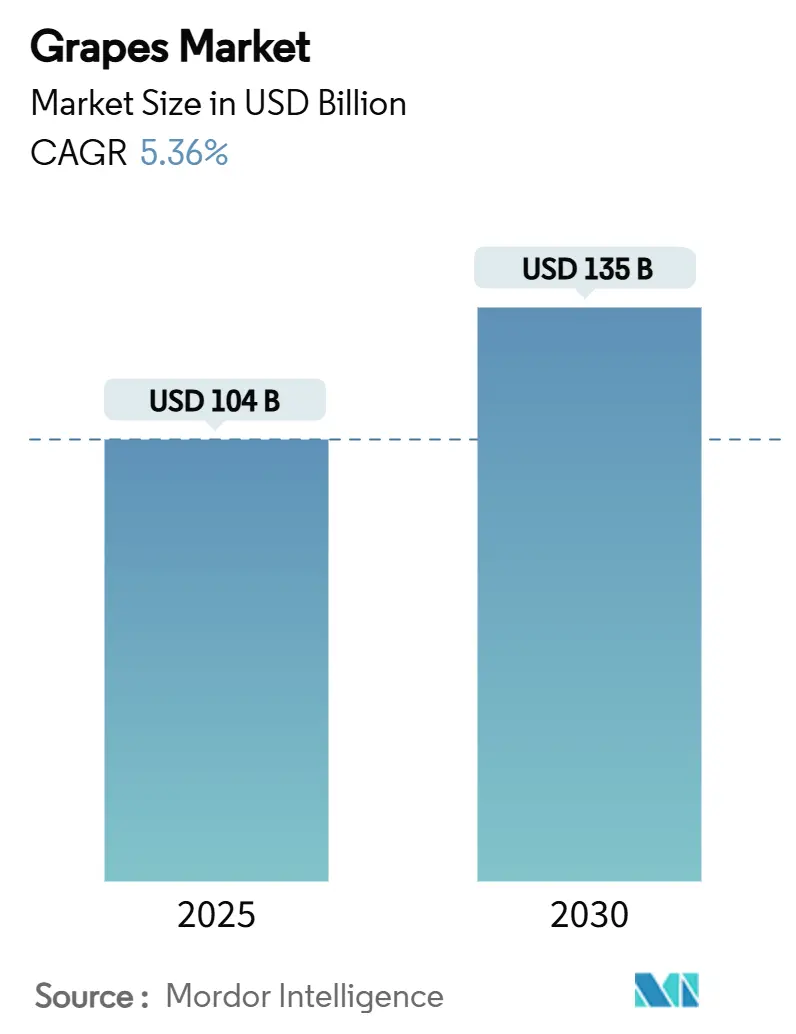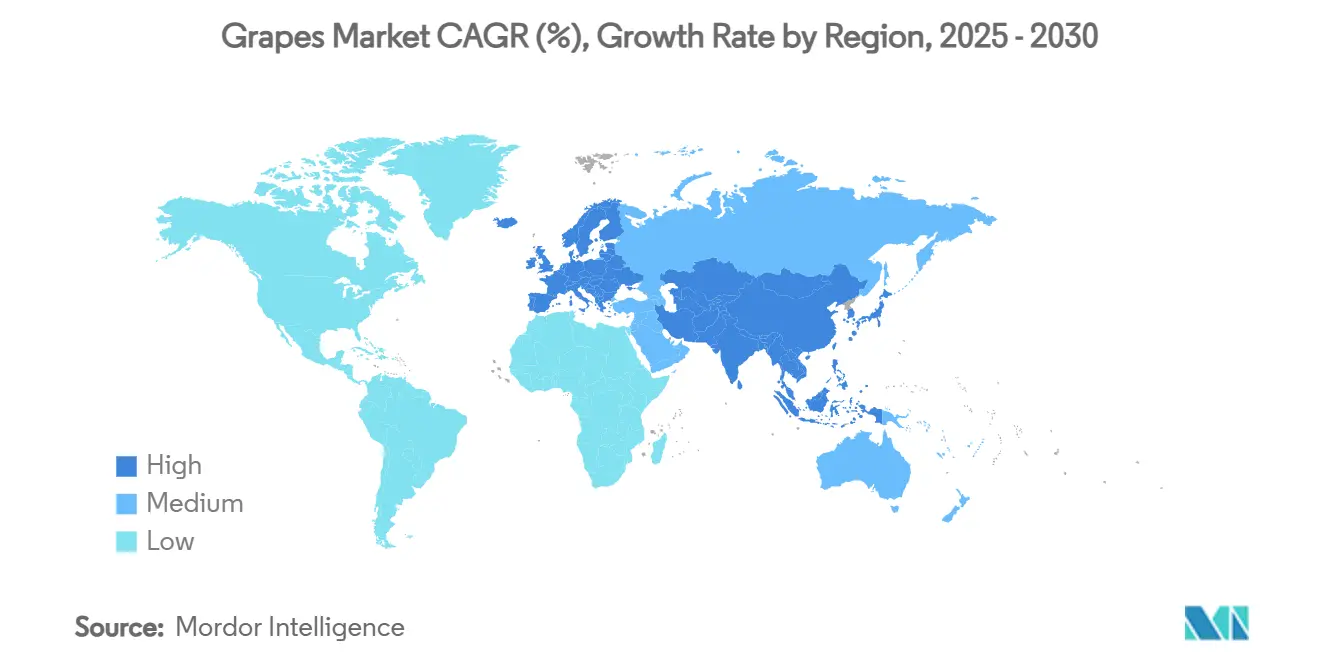Grapes Market Size and Share

Grapes Market Analysis by Mordor Intelligence
The grapes market size is valued at USD 104.0 billion in 2025 and is forecast to reach USD 135.0 billion by 2030, advancing at a 5.36% CAGR over the period. Rising appetite for premium seedless varieties, a pivot toward functional ingredients, and steady investments in precision viticulture support this trajectory. Increasing cold-chain reach in emerging economies curbs post-harvest losses, while climate-resilient breeding programs preserve productive acreage in heat-stressed zones. Retailers that focus on environmental metrics encourage organic certification, and technology adoption lowers labor intensity amid acute worker shortages. Strategic divestitures by multi-brand beverage firms shift value toward specialized growers that pair terroir stories with direct-to-consumer channels.
Key Report Takeaways
- Europe accounted for 32.5% of grape consumption in 2024, and Asia-Pacific consumption is projected to grow at a 7.0% CAGR through 2030.
Global Grapes Market Trends and Insights
Drivers Impact Analysis
| Driver | (~) % Impact on CAGR Forecast | Geographic Relevance | Impact Timeline |
|---|---|---|---|
| Premiumization of table-grape varieties | +1.2% | North America and Europe | Medium term (2-4 years) |
| Surge in functional grape-based nutraceuticals | +0.9% | Asia-Pacific with spill-over to North America | Long term (≥ 4 years) |
| Expansion of cold-chain logistics in emerging economies | +0.8% | Asia-Pacific, Middle East, Africa | Medium term (2-4 years) |
| Growth in organic certification acreage price premiums | +0.7% | Europe, North America, and the emerging Asia-Pacific | Long term (≥ 4 years) |
| AI-enabled precision viticulture adoption | +0.6% | North America and Europe | Medium term (2-4 years) |
| Climate-resilient cultivar R&D incentives | +0.5% | Global climate-vulnerable belts | Long term (≥ 4 years) |
| Source: Mordor Intelligence | |||
Premiumization of Table-Grape Varieties
Retail audits show a 15–25% price premium for proprietary seedless cultivars that guarantee crunch, high Brix, and extended shelf life [1]Source: Foreign Agricultural Service, “Fresh Apples, Grapes, and Pears: World Markets and Trade,” United States Department of Agriculture, fas.usda.gov . Seven-year breeding cycles for selections such as Jupiter illustrate the capital and patience needed to secure trademarks that defend shelf space. Retailers now require optical sizing and modified-atmosphere punnets, raising the baseline for post-harvest technology. As climate variability tightens harvest windows, breeding programs also emphasize heat tolerance to protect flavor integrity across the grapes market.
Surge in Functional Grape-Based Nutraceuticals
Polyphenol concentrates earn wholesale prices above USD 50 per kilogram, around twenty times fresh-fruit equivalents, motivating processors to invest in super-critical CO₂ lines that meet pharmaceutical standards. United States Food and Drug Administration GRAS status eases product registration, while direct farm contracts secure high-anthocyanin varieties. This dynamic nudges growers to select clones with thicker skins, reinforcing vertical integration opportunities inside the grapes market. Dedicated polyphenol processing hubs are now forming near major table-grape clusters in California and La Rioja, cutting raw-material haulage costs and tightening quality control. Early-stage venture funding is also flowing into startups that apply membrane filtration to boost extract yields by up to 15%, a gain that lifts processor margins and widens the addressable space for functional beverages.
Expansion of Cold-Chain Logistics in Emerging Economies
Egypt’s new reefers deliver fruit to European hubs in under forty-eight hours with quality retention near 95%. Lower spoilage attracts export-oriented investments across berries and avocados, creating cross-crop economies of scale. Temperature-controlled corridors also allow Southern Hemisphere exporters to capture off-season premiums, expanding regional reach for the grapes market. Inland pre-cooling stations now link farm gates to port terminals by chilled truck convoys, trimming transit variability and meeting stricter retailer freshness metrics. Real-time data loggers embedded in reefers feed blockchain traceability dashboards that reassure buyers on cold-chain integrity and speed customs clearance for high-value organic shipments.
Growth in Organic Certification Acreage Price premiums
Price premiums of 20–40% offset the three-year transition cost for organic certification. Harmonized European Union and United States rules let growers access multiple destinations with one audit, lowering per-unit costs. Cover crops, compost teas, and biological controls enhance soil health and sustain long-term productivity in the grapes market even as synthetic inputs phase down. Large retailers increasingly require carbon footprint disclosures alongside organic labels, steering capital toward vineyard energy audits and solar-powered irrigation. Banks now offer sustainability-linked loans that cut interest rates up to 75 basis points once organic status is verified, accelerating acreage conversion pipelines.
Restraints Impact Analysis
| Restraint | (~) % Impact on CAGR Forecast | Geographic Relevance | Impact Timeline |
|---|---|---|---|
| Escalating labor shortages in vineyards | −0.8% | North America and Europe | Short term (≤ 2 years) |
| Stricter maximum residue level (MRL) compliance | −0.6% | Global export hubs | Medium term (2-4 years) |
| Volatile ocean-freight rates post-2025 | −0.5% | Key Asia–Europe and Americas–Europe Sea lanes | Short term (≤ 2 years) |
| Grapevine trunk-disease proliferation | −0.4% | Mediterranean with spill-over to other wine regions | Long term (≥ 4 years) |
| Source: Mordor Intelligence | |||
Escalating Labor Shortages in Vineyards
California and Spanish wage bills rose 25–35% in one year as workers shifted to logistics and construction[2]Source: Climate Change Connections: California Grapes, U.S. Environmental Protection Agency, epa.gov . Robotic harvest units priced at USD 200,000–500,000 remain viable only for blocks above forty hectares, disadvantaging artisanal estates that rely on hand picking. Seasonal-visa caps in the United States trimmed available crews by 18% for the 2025 harvest, forcing growers to leave premium clusters unpicked. Cooperative hiring pools are emerging in Spain’s Ribera del Duero to share skilled pruners across neighboring estates, but travel allowances inflate total labor costs and tighten already thin margins.
Stricter Maximum Residue Level (MRL) Compliance
European Union tolerance cuts add USD 0.15 per kilogram to compliance and double sampling times [3]Source: Egypt Fresh Deciduous Fruit Annual, Foreign Agricultural Service, U.S. Department of Agriculture, fas.usda.gov . As smallholders defer lab upgrades, trade flows consolidate around large exporters able to finance multi-market protocols. Retail buyers now demand blockchain-stamped spray records that prove interval timing, compelling growers to adopt digital field logs and sensor-verified application tools. Pivoting to biological pesticides lifts per-acre material spend by 12% in high-pressure zones, but it is increasingly the only route to keep shipments within tightening residue ceilings.
Geography Analysis
Europe retains 32.5% of 2024 consumption, anchored by protected designations and premium wine pricing. Organic acreage climbs 12–15% annually, and common agricultural policy funds subsidize regenerative practices, yet 2024 heat waves trimmed Mediterranean yield. Growers add shade nets and deficit irrigation to sustain output. Breeders in Spain and Italy are fast-tracking heat-resistant rootstocks that preserve acidity under 40 °C field conditions, protecting flagship appellations. Meanwhile, tighter maximum residue rules push cooperatives to install centralized testing labs, a move that lowers per-sample costs for smallholders and keeps exports compliant with Northern European supermarket contracts.
Asia-Pacific registers the fastest regional CAGR at 7.0% through 2030. China’s 12.6 million metric tons harvest leads output, yet domestic demand absorbs volume, opening import windows for Australian and Peruvian exporters. India’s 2.85 million metric tons crop relies on upgraded pack houses that meet European retailer specs. Varietal programs in Australia pivot to drought-tolerant clones, keeping the grapes market resilient as rainfall declines. E-commerce grocers in South Korea and Japan now bundle premium seedless boxes with next-day delivery, widening urban penetration and lifting average selling prices. Regional cold-chain spending is projected to top USD 5 billion by 2027, a build-out that secures longer shelf life for counter-seasonal shipments into Southeast Asian megacities.
North America posts a 4.6% CAGR to 2030 despite California’s smallest red-grape harvest in twenty-two years. Mechanized pruning and regenerative trials in Mexico and Canada buffer the regional grapes market against labor and climate shocks. Washington State is expanding high-density trellis systems coupled with drip fertigation, a shift that raises yield per acre and trims water use by 18%[4]Source: Foreign Agricultural Service, “Washington Wine Grape Production Report 2024,” United States Department of Agriculture, fas.usda.gov. In British Columbia, growers employ wind machines and multi-row netting to guard buds after the 2024 winter kill, a strategy that restores partial output while longer-term replanting takes place.

Recent Industry Developments
- July 2025: ICAR-NRCG (Indian Council of Agricultural Research - National Research Centre on Grapes) has recently signed a Memorandum of Understanding (MoU) to expand grape cultivation in Kashmir. Kashmir is known for its apple farming, but now all efforts are being made to promote grape cultivation in non-traditional areas to accelerate its productivity. The ICAR-National Research Centre for Grapes (ICAR-NRCG) has left no stone unturned in the expansion of grape cultivation in the Kashmir Valley.
- February 2025: Berkshire Hathaway invested USD 1.24 billion in Constellation Brands, bolstering the company’s premium wine strategy.
- December 2024: An AI-powered grape-harvesting robot debuts at an Essex vineyard. This robotic system, created in collaboration with Queen Mary University researchers, is designed to identify ripe grapes using AI-driven visual sensors that measure internal sugar levels, ensuring the fruit's integrity.
Global Grapes Market Report Scope
Grapes are either consumed fresh as table grapes or processed into different forms, such as wine, raisins (dried grapes), jams, jellies, and juices. For this report, the market is limited to freshly traded grapes used for tables or processing purposes. The grape market is segmented by geography (North America, Europe, Asia-Pacific, South America, and Africa). A detailed analysis of the production (volume), consumption (value and volume), imports (value and volume), and exports (value and volume), along with pricing and value chain analysis, has been provided in the report. The report provides market size and forecasts for all of the above segments in terms of volume (metric tons) and value (USD).
| North America | United States |
| Canada | |
| Mexico | |
| Europe | Germany |
| France | |
| Italy | |
| United Kingdom | |
| Asia-Pacific | China |
| India | |
| Japan | |
| Australia | |
| South America | Brazil |
| Argentina | |
| Chile | |
| Peru | |
| Middle East | Turkey |
| Saudi Arabia | |
| Africa | South Africa |
| Egypt |
| By Geography (Production Analysis (Volume), Consumption Analysis (Volume and Value), Import Analysis (Volume and Value), Export Analysis (Volume and Value), and Price Trend Analysis) | North America | United States |
| Canada | ||
| Mexico | ||
| Europe | Germany | |
| France | ||
| Italy | ||
| United Kingdom | ||
| Asia-Pacific | China | |
| India | ||
| Japan | ||
| Australia | ||
| South America | Brazil | |
| Argentina | ||
| Chile | ||
| Peru | ||
| Middle East | Turkey | |
| Saudi Arabia | ||
| Africa | South Africa | |
| Egypt | ||
Key Questions Answered in the Report
Which region consumes the most grapes?
Europe leads with 32.5% of global consumption due to its established wine and table-grape culture.
Which geography is growing the fastest?
Asia-Pacific consumption is forecast to climb at a 7.0% CAGR through 2030, driven by China and India.
What technological shift is reshaping vineyards?
AI-enabled precision viticulture, including sensor-driven irrigation and robotic harvesting, is reducing inputs and stabilizing yields.
Why are polyphenol extracts important?
Grape-derived polyphenols command prices above USD 50 per kilogram and feed high-margin nutraceutical and cosmetic products.
How are producers coping with labor shortages?
Larger vineyards invest in robotic harvesters and mechanized pruning while smaller estates explore seasonal worker retention programs.
Page last updated on:


